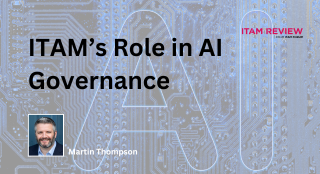How to reduce e-waste – ITAM’s role in meeting sustainability goals
A recent report & survey by the UK’s Royal Society of Chemistry (RSC) has highlighted the growing problem of how to reduce e-waste and how we can do more to reduce consumption of rare earth metals and shore up overstretched supply chains. The report also includes some surprising findings related to remote work, and certainly challenged my preconceptions around which countries are most concerned about the environmental impact of e-waste.
Report & Survey findings
The RSC research states the current rate of consumption of precious and rare earth metals is unsustainable. The solution they propose is that we “mine” e-waste, rather than mine the Earth. This is a considerable resource which is currently woefully underutilized – in 2021 it was estimated that global e-waste weighed 57 million tonnes. That figure is currently growing by around 2 million tonnes per year, and most critically, only around 20% of e-waste is collected and recycled.
Where’s the rest of it? If you’re anything like me it’s in cupboards, drawers, garages, and attics. For businesses it’s most likely to be stuck in your colleagues’ desk drawers or increasingly in their homes, particularly without robust HAM processes which have been updated for the move to remote and hybrid working.

The impact of home working
The RSC’s research was conducted in October 2021 and surveyed 20,000 people worldwide. Key findings relevant to home-working include:
- 30% of people have taken office equipment home for work
- 23% have received new equipment from their employer, and 26% have purchased their own
- 11% of people have just discarded old equipment rather than recycling it
- 10% have a stockpile of redundant kit, and just under 15% have recycled equipment
The statistics show that 9% of company owned devices are left for employee to dispose of when they reach end of life, and just 20% of companies ask employees to return broken devices for repair. Employees disposing of company-issued devices should be of particular concern – and is likely to be a compliance breach in certain industries and territories.
Overall, these figures indicate that we’re not yet doing a good job of managing end-of-life and repair/return with respect to homeworking. This is an opportunity for ITAM and HAM teams to step up and make a significant contribution to the reduction of e-waste, as well as looking at IT Asset Disposition (ITAD) to reduce disposal entirely.
Voting with our wallets
One of the most interesting questions raised by the survey was around the cost of buying sustainable electronics. The survey was conducted prior to the global inflation shocks we’re currently experiencing but there was still a majority in favour of having devices which lasted longer, were more repairable, and less likely to suffer from software-enforced obsolescence, even if it meant that those devices were more expensive. It will be interesting to see how many of us “sweat” our assets for longer in the face of rising prices and falling real incomes. On average, 60% of survey respondents cited software-enforced obsolescence as a key driver of new device purchases and the same number also stated they’d switch brands if a rival’s device was proven to be more sustainably produced. That, if anything, should be ringing alarms bells in Apple. The exceptions to this were the UK and Japan, both of whom appear particularly wedded to their chosen brands – with a majority stating they wouldn’t switch, even if a device was more sustainable.
What can we do to reduce e-waste?
For IT Asset Managers this is an opportunity to drive the sustainability agenda within our organizations, work with new and powerful stakeholders, and reduce the impact of our IT operations on the planet.
I’m sure I’m not alone in having gathered IT equipment from previous employers when I’ve left their employment. Either I was allowed to keep it, or perhaps it was just forgotten about and so a return wasn’t requested. When most employees were office-based this was usually a small-scale issue because offices tended to have good physical security – e.g. a front desk, turnstiles, security guards, CCTV. If a device wasn’t returned, at least you could be reasonably certain that it was still within the secure walls of the office.
The survey shows that we simply don’t have great hardware asset lifecycle processes in place. We likely don’t know who a device is assigned to and aren’t joined up enough perhaps with other stakeholders in the employee and hardware journey. For example, perhaps we don’t record when an asset is issued to an employee, or don’t provide that information to HR & Helpdesk when the employee leaves.
Closing these gaps is important, and not just for ESG (Environmental, Social, and Governance) objectives. If we don’t know where our hardware is, we don’t know where our sensitive data is. And that applies to many classes of devices including printers, mobile phones, alongside more traditional computing devices. Work with HR, IT Helpdesk, and Identity & Access Management to improve the Joiners, Movers, and Leavers process.
Doing so will reduce costs – by providing used equipment for redeployment internally – and also reduce the considerable environmental impact of a net new hardware purchase (and thereby reduce e-waste). Over 80% of the total environmental cost of ownership of an electronic device is accrued in its production and distribution. Rather than jumping straight to mining our e-waste, as the RSC suggests, having the right ITAM processes in place will keep our devices out of the e-waste pile for longer.
Learn more about how to reduce e-waste at Wisdom EMEA 2022
If you want to learn more about Sustainable ITAM, join me in at Wisdom EMEA on 16th June @ 11.30. In this session, “ITAM and Sustainability. How to Save the Planet and Get Promoted,” I will present models for establishing a circular economy within IT, leveraging ITAM’s unique knowledge of the hardware and software running in our estates. We will look at the growth of Sustainability as a top-level corporate objective and provide a roadmap for engaging with powerful stakeholders such as Chief Sustainability Officers.
Further reading on e-waste, HAM and ITAD
UK government misses opportunity to address “e-waste tsunami”
Now is the time to think about ITAD
IT Asset Disposal vs. IT Asset Disposition
Can’t find what you’re looking for?
More from ITAM News & Analysis
-
Broadcom vs Siemens AG - A Brewing Storm
The ongoing legal battle between VMware (under Broadcom ownership) and Siemens is yet another example of why ITAM goes far beyond license compliance and SAM. What might, at first glance, appear to be a licensing dispute, ... -
Shifting Left Together: Embedding ITAM into FinOps Culture
During one of the keynotes at the FinOps X conference in San Diego, JR Storment, Executive Director of the FinOps Foundation, interviewed a senior executive from Salesforce. They discussed the idea of combining the roles of ... -
Addressing the SaaS Data Gap in FinOps FOCUS 2.1
I recently reported on the FinOps Foundation’s inclusion of SaaS and Datacenter in its expanded Cloud+ scope. At that time, I highlighted concerns about getting the myriad SaaS companies to supply FOCUS-compliant billing data. A couple ...
Podcast
ITAM training
Similar Posts
-
The M&S Cyberattack: How IT Asset Management Can Make or Break Your Recovery
Marks & Spencer (M&S), the iconic UK retailer, recently became the latest high-profile victim of a devastating cyberattack. Fellow retailers The Co-Op and Harrods were also attacked. Recent reports suggest the rapid action at the Co-Op ... -
AI in ITAM: Insightful Signals from the Front Line
During our Wisdom Unplugged USA event in New York in March 2025, we engaged ITAM professionals with three targeted polling questions to uncover their current thinking on Artificial Intelligence—what concerns them, where they see opportunity, and ... -
How ISO/IEC 19770-1 Can Help Meet FFIEC Requirements
In the world of ITAM, the regulatory spotlight continues to intensify, especially for financial institutions facing increasing scrutiny from regulatory bodies due to the growing importance of IT in operational resilience, service delivery, and risk management. ... -
An Introduction to Scope 4 Emissions
Executive Summary For ITAM teams, sustainability is a core responsibility and opportunity. Managing hardware, software, and cloud resources now comes with the ability to track, reduce, and report carbon emissions. Understanding emission scopes—from direct operational emissions ...




